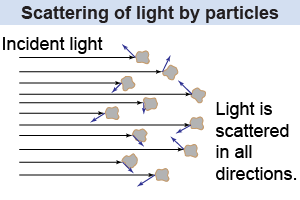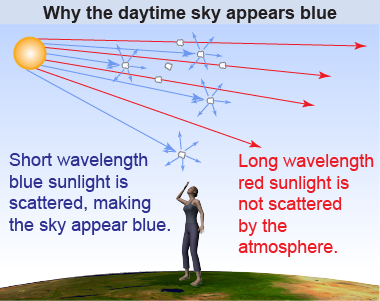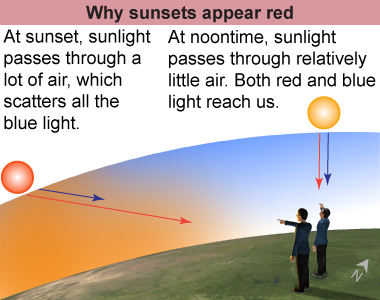|

| If air is clear, why is the sky blue? If you look up on a clear day, and don’t look directly at the Sun, you see a blue sky instead of the black of space. The explanation of the blue sky involves the effects of reflection, refraction, and dispersion together. Every cubic centimeter of air contains small particles of dust and water droplets. When light strikes these particles some fraction of the light is absorbed and subsequently re-emitted—usually in a different direction. Scattering is the process of small particles absorbing and re-emitting light. |

|
Scattering depends on the sizes of the particles and the wavelength of the incident light. Just as long-wavelength water waves can easily pass around small stones, long-wavelength light waves can pass by small particles in the atmosphere. Short wavelength-light—blue or violet in color—can be scattered by both small and large particles in the atmosphere. 
|
On page 21 we learned that colors of light on a digital device can be represented as combinations of the additive primary colors: red, green, and blue. When all three colors appear in equal amounts, the result is white light; the absence of all three colors is black. At night there is no sunlight, so the night sky appears black. 
|
 When you look away from the Sun in the daytime sky, you are seeing sunlight scattered by the particles of the atmosphere. The small particles in the atmosphere scatter much more blue light than they scatter red light, because blue light has shorter wavelengths that are similar in size to the atmospheric particles. The sky appears blue because blue light is preferentially scattered into your eyes by atmospheric particulates. Red light is not scattered as much and mostly travels straight from the Sun to the ground.
When you look away from the Sun in the daytime sky, you are seeing sunlight scattered by the particles of the atmosphere. The small particles in the atmosphere scatter much more blue light than they scatter red light, because blue light has shorter wavelengths that are similar in size to the atmospheric particles. The sky appears blue because blue light is preferentially scattered into your eyes by atmospheric particulates. Red light is not scattered as much and mostly travels straight from the Sun to the ground. 
 |
The scattering of light by particles that produces the blue sky is called Rayleigh scattering. This kind of scattering of light, both by particles and by molecules, depends very strongly on the wavelength of the light. In fact, the probability of scattering varies inversely with wavelength to the fourth power! Since blue light has shorter wavelengths than red light, the probability of scattering increases as the ratio of the wavelengths of red to blue light to the fourth power, which is a very strong effect.
Note that this means that a little bit of red light is actually scattered by the atmosphere—but not nearly as much blue light is scattered. 
|
 At sunset, the Sun is very near the horizon. This means that the path of the Sun’s light must pass through much more air to reach our eyes near sunset than it does near noontime. All that extra air results in more and more scattering of the Sun’s blue wavelengths—until there is little or no blue light left. Sunsets appear reddish-orange because all the blue light from the Sun has been scattered by the time the light reaches your eyes because of its long path through air.
At sunset, the Sun is very near the horizon. This means that the path of the Sun’s light must pass through much more air to reach our eyes near sunset than it does near noontime. All that extra air results in more and more scattering of the Sun’s blue wavelengths—until there is little or no blue light left. Sunsets appear reddish-orange because all the blue light from the Sun has been scattered by the time the light reaches your eyes because of its long path through air. 
|
Does air scatter longer or shorter wavelengths of light better?
 |
Air scatters shorter wavelengths of light, such as blue, better than it does longer wavelengths, such as red. This is why sunsets are red. 
|

